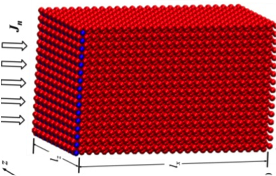Swelling during charging induces stresses, and stresses have an influence on the diffusion that is necessary for charging to proceed. We have developed the fully-coupled continuum theory for this process, including the key factor of a stress-dependent migration barrier for transport. We have used the system of Ni-H, where all inputs to the theory can be computed a priori, to simulate charging using MD. The continuum model shows excellent agreement with the full MD, down to nanometer scales. Turning off various terms in the chemical potential also for understanding of the role of each term in controlling the overall diffusion.

Si has the highest Li capacity of any elemental material and, with a low density, is an attractive candidate anode material. Si amorphizes during the first charging, and the subsequent Si-Li amorphous material exhibits plastic flow. We have developed a full theory for the dependence of the temperature and strain-rate-dependent flow stress as a function of the charging history of the material. The key idea is that charging and discharging inject excess energy into the material and this excess energy facilitates easier plastic flow. Relaxation processes in the glassy material act to relax the excess energy, however, so that the plastic flow is a competition between excess energy creation and annihilation. We have used MD models of Si-Li to demonstrate explicitly various aspects of the physical model.
Key publications:
- H. Haftbaradaran, H. J. Gao, and W. A. Curtin, “A surface locking instability for atomic intercalation into a solid electrode”, App. Phys. Lett. 96, Art# 091909 (2010).
- J. Song*, H. Haftbaradaran, W. A. Curtin, and H. J. Gao, “Continuum and Atomistic Models of Strongly-coupled Diffusion, Stress, and Solute Concentration”, J. Power Resources 196, 361-370 (2011).
- M. Koshrownejad and W. A. Curtin, in preparation.